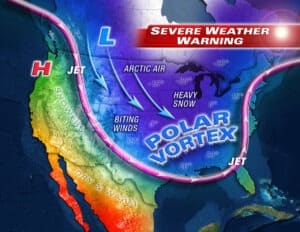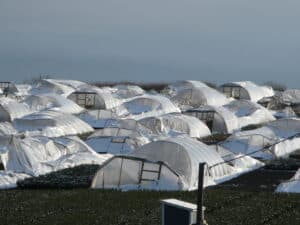Energy Efficient Greenhouse Covering is Essential for Climate Change
 Last year’s Polar Vortex and this year’s major snow events illustrate how these larger scale weather occurrences have a major impact on reducing the payback period for greenhouse energy conservation projects. As outside temperatures drop below normal, energy consumption goes up. In addition, insurance companies might force a grower to heat an empty greenhouse or increase the normal heat input in an active greenhouse. With a more energy efficient greenhouse covering, these added costs can be reduced. When you take a good hard look at the numbers, it makes more sense than ever to invest in energy efficient greenhouse covering.
Last year’s Polar Vortex and this year’s major snow events illustrate how these larger scale weather occurrences have a major impact on reducing the payback period for greenhouse energy conservation projects. As outside temperatures drop below normal, energy consumption goes up. In addition, insurance companies might force a grower to heat an empty greenhouse or increase the normal heat input in an active greenhouse. With a more energy efficient greenhouse covering, these added costs can be reduced. When you take a good hard look at the numbers, it makes more sense than ever to invest in energy efficient greenhouse covering.
Weather Extremes – Like a Polar Vortex – are the New Normal
For example, let’s consider the impact of a Polar Vortex event on a grower in Kalamazoo, Michigan. According to Jeffrey Andresen, the State Climatologist for Michigan, “The normal mean temperature during the winter months (DJF – December, January, and February) in Kalamazoo is 26.7°F (based on 1981-2010 normals). During the severe winter of 2013/2014, the mean DJF temperature was 20.1°F or 6.6°F below for Kalamazoo”.
Utilizing the USDA-ARS Virtual Grower software, a representative 100’ long x 25’ wide 4 year double polyethylene (R-value 1.7) covered greenhouse in Kalamazoo saw an increase in energy consumption of almost $1,300 compared with the same greenhouse under normal Kalamazoo winter temperatures. The same greenhouse covered with an energy conserving product like 5 MM Solexx (R-value 2.3) greenhouse covering only experienced energy increases in the same Polar Vortex weather conditions of a little more than $820. That’s $480 worth of energy savings in one winter.
So how does all of this impact the payback period of recovering a greenhouse with Solexx? Let’s look at the numbers. The additional energy costs reduce the payback period (solely based on energy savings) to recover the greenhouse with Solexx versus double polyethylene film by almost a year (0.85 years). With the past weather patterns, the projects payback period was 4 years, but with just one extreme winter, the payback period dropped to 3.15 years.
Heavy Snow Adds Substantial Business Costs to a Poly Greenhouse
 Growers are often forced to run heaters in an empty greenhouse or increase the heat in an occupied greenhouse to help melt the snow and fulfill the requirements imposed by some insurance carriers. This requirement helps prevent the heavy snow load from collapsing a greenhouse (see picture). These increased energy costs are often the sole financial responsibility of the greenhouse grower.
Growers are often forced to run heaters in an empty greenhouse or increase the heat in an occupied greenhouse to help melt the snow and fulfill the requirements imposed by some insurance carriers. This requirement helps prevent the heavy snow load from collapsing a greenhouse (see picture). These increased energy costs are often the sole financial responsibility of the greenhouse grower.
Another option an insurance company may require is to “cut the plastic” and allow the snow to fall into the structure. This practice saves the greenhouse, but prevents it from being an income-generating venture. Any plants still in the greenhouse would also be collateral damage.
Both of these options cost the greenhouse grower money. As extreme cold events occur more frequently, your business costs will continue to increase and you will lose valuable time spent working with your insurance adjuster. A grower’s choice of greenhouse covering can also impact their annual premium. Greenhouse growers should check with their insurance company to better understand their policy specifics.
Energy Efficient Greenhouses Help Mitigate the Threat of Heavy Snow
If we go back to the previously used example, under normal Kalamazoo weather conditions according to Virtual Grower, it would cost $1,679 to heat the double polyethylene covered greenhouse for the month of January to melt the snow off the roof. This assumes you normally would not start to heat the greenhouse until February. If the greenhouse was covered by a greenhouse covering like Solexx that allowed the snow to quickly slide off and did not accumulate, and you were saved the additional energy expense, then the payback period for recovering with the Solexx would drop from 4 years under normal conditions to just 3.05 years under a major snow fall event. This almost one year reduction in the payback period under this circumstance can change an energy conservation project from being reasonable, to a “no brainer.”
Now with the “new normal” being abnormal weather events like the Polar Vortex or Major Snow Events, it is important for growers to consider these factors when they decide on a greenhouse energy conservation improvement project, like recovering with Solexx greenhouse coverings. Greenhouse energy conservation projects reduce grower’s risks. They can provide a level of insurance against future energy increases, potential damage from major reduced temperature weather events (Polar Vortex) and effects of large scale snow weather patterns (i.e. Boston 2015) that you cannot find coverage for in a traditional property insurance policy.

